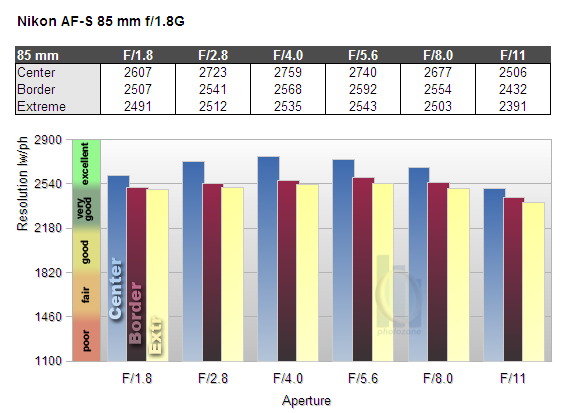|
Page 2 of 2

Distortion
On DX cameras the lens is free of distortion.

The chart above has a real-world size of about 120x80cm.
Vignetting
Being a FX lens, the Nikkor profits from the sweet spot advantage on DX cameras and consequently shows only moderate vignetting wide open, which is reduced to an irrelevant level at f/2.8 and beyond.

MTF (resolution)
The lens delivers excellent resolution in the image center straight from the maximum aperture and stays on this high level down to f/8. From f/11 onwards, diffraction significantly reduces the resolution figures.
Borders and corners follow a bit behind with very good resolution wide open. Stopped down to medium aperture settings both borders and corners manage to reach excellent sharpness, too.
The lens showed a small amount focus shift when stopping down (residual spherical aberration).
Please note that the MTF results are not directly comparable across the different systems!
Below is a simplified summary of the formal findings. The chart shows line widths per picture height (LW/PH) which can be taken as a measure for sharpness.
If you want to know more about the MTF50 figures you may check out the corresponding Imatest Explanations

Chromatic Aberrations (CAs)
Chromatic aberrations (color shadows at harsh contrast transitions) are moderate with an amount of roughly 0.7 to 1.2 pixels at the image borders. They decrease by stopping down, so are most pronounced at large apertures.
However, CAs can easily be corrected in software or by the camera itself (most modern Nikon DSLRs remove CAs themselves if you shoot JPGs).

Bokeh
One of the primary usage scenarios for a large aperture lens is to seperate the main subject from the background. In such an image the quality of the bokeh (out-of-focus blur) is of major significance.
The lens produces quite smooth background blur wide open, even in the sometimes critical transition zone.
Thanks to 7 rounded aperture blades, background highlights retain their circular shape at least for larger aperture setting. From f/4 onwards however the highlights start to show traces of a more polygonal shape, which becomes even more obvious at f/5.6 (and smaller apertures). Due to mechanical vignetting the highlights are slightly cut off towards the image corners wide open, but of course the cut-off is less pronounced than on FX cameras. Typical for this lens class, there is also some bokeh fringing around background highlights (see also next section).

Bokeh Fringing
Bokeh fringing is a common issue with relatively fast glass. It's visible as halos of different colors in out-of-focus areas - magenta (red + blue) in front of the focus point
and green beyond.
Typical for most fast primes, the AF-S 85 shows noticeable bokeh fringing at large aperture settings, which can of course be reduced by stopping down.
In addition, these shots also show the slight focus shift when stopping down, which was mentioned in the MTF section.
The predecessor of this lens, the AF-D 85/1.8, is well known for a tendency to emphasize purple fringing at large apertures. While we haven't had a chance to test the new AF-S 85/1.8 regarding this issue in the field (due to lack of strong sunshine), the lab tests did not indicate such a behaviour. As can be seen in the shots below, reflecting surfaces show bokeh fringing when not exactly in focus, but there's a neutral zone with no fringing in the focus plane. As mentioned above, stopping down reduces the amount of fringing considerably.
|
Move the mouse cursor over the f-stop marks below to observe the respective fringing
|
| f/1.8 |
f/2.8 |
f/4.0 |
|

|
Sample Images
You can find some sample images taken with the Nikon D3x in our Nikon FX review of the lens.
VerdictThe Nikkor AF-S 85mm f/1.8 G is an excellent lens. It performs on a very high level in almost any regard, even on the high resolution DX sensor of the Nikon D7000. Sharpness is excellent in the image center straight from the largest aperture, the borders and corners deliver very good resolution wide open and excellent sharpness stopped down.
Typical for a fast prime there is some vignetting wide open, which can easily be cured by stopping down. The same applies to Bokeh fringing. CAs are on a moderate level, while distorion is no issue at all. The biggest surprise is probably the bokeh quality, which is not right up there on the benchmark level set by 85mm f/1.4 lenses, but quite close.
The build quality is on a high level and in line with other Nikon consumer prime offerings. Thanks to an AF-S drive autofocus action is virtually silent and quite fast for a portrait lens.
So, in summary, the verdict remains the same as in our earlier FX review: for most subjects the lens gives around 95% of the performance of an AF-S 85/1.4 but at just one third of the price. Certainly highly recommended!
|